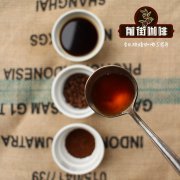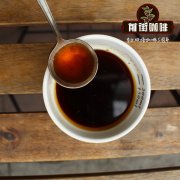[Katim] the planting history of the variety? Are Yunnan Katim coffee beans delicious? What are the advantages and disadvantages?

Professional coffee knowledge exchange more coffee bean information please follow the coffee workshop (Wechat official account cafe_style)
[Katim] the planting history of the variety? Are Yunnan Katim coffee beans delicious? What are the advantages and disadvantages? How to cook it?
At present, most of the plants in Yunnan are Katim, which is a hybrid of Kaddura and Robsta, a branch of the bourbon line in the Arabica species. The reason for planting this variety is that Katim has the Robusta gene, so it is better than a single old variety in disease resistance, and the yield is good. Compared with the delicate old variety, the disease resistance is poor and the yield is low. Farmers naturally prefer to plant Katim. So now there has been a Katim wind in Yunnan.
From 26 to 28 February 2001, the Royal Planning Foundation of Thailand and the United Nations Food and Agriculture Organization jointly organized an event entitled "The First Asian Regional Round-Table on Sustainable, Organic and Speciality Coffee Production, Processing and Marketing" in Chiang Mai (the first Round Table on Sustainable, Organic and refined Coffee production, processing and Marketing in Asia). During the meeting, Dr. Ernesto Illy, the boss of the Italian Illy Coffee Company, mentioned the poor quality of Katim coffee in his speech "the negative factors in the quality of coffee raw beans." Because it has 25% robusta coffee gene, although it enhances the ability to resist rust, its quality is reduced by its influence.
In order to improve the poor evaluation of the Catimor Cartim Cup, in recent years botanists from all over the world have turned to the interbreeding of Arabica and Katim for many generations, in an attempt to reduce the Robusta pedigree and improve the elegant flavor of Arabica, thus cultivating a new generation of Katim, including [CatimorH528], [CatimorH306], and [CatimorT5175] and [CatimorT8667] of Costa Rica. But Costa Rica has abandoned the cultivation of Kadim, focusing on Kaddura varieties, and exporting the improved Kadim to Asian countries. There are countless Katim strains, and the cup test results and habits of each strain are also different, but although it has been improved for many years, Katim has not yet entered the top 30 list of the International Cup. Kadim's biggest fatal injury is that it is not inferior to Kaddura, Kaduai or bourbon beans grown at low altitude, but the cup test results planted at high altitude are significantly lower than those of bourbon, Kaduai or Kaddura. It remains to be seen whether Kadim can ascend to the Hall of Great elegance. Looking forward to one day to cultivate a super Kadim suitable for high altitude, shocked the boutique coffee industry.
Catimor, from the hybrid of timor and caturra, was developed by CIFC, a coffee leaf rust research center in Portugal in 1959. Its research direction is disease resistance and high yield. Catimor has high yield, short plant, dense planting and red-brown new leaves. The robusta gene inherited from timor makes catimor more resistant to coffee berry disease, coffee leaf rust and insect pests, but it is often criticized for its performance in the cup. Catimor fruit ripens quickly and has high yield, which requires adequate fertilizer supply and shading. In addition, the high yield of catimor corresponds to a relatively shorter commercial life, with an average of only ten years. When growing at low altitude, the cup performance of catimor has no obvious advantages and disadvantages compared with other commercial varieties. When planted above 1200 meters above sea level, the flavor of catimor cup is obviously inferior to that of bourbon, caturra and catuai. Catimor was first developed in 1959 and was popularized in Brazil in the 1970s and 1980s. With disease resistance and high yield, it occupies a place in Central and South American coffee varieties. The occasional outbreak of coffee leaf rust crisis in Central and South America has also contributed to the application of catimor.
It was hybridized with rust-resistant Timor and Caturra in Portugal in 1959. It has early maturity and strong disease resistance, and its yield is much higher than that of other varieties with commercial value. For this reason, we must be diligent in fertilization and pay attention to shading. The offspring of Catimor TMel 8667 are relatively short, but their fruits and seeds are very large. Catimor line TMel 5269 is very strong and suitable for growing in areas with an altitude of 600m-900m and annual rainfall of more than 3000 centimeters. The Tmur5175 is highly productive and robust, but it can be troublesome at too high or too low altitudes. At low elevations, its quality is similar to that of other varieties of commercial value, but above 1200 meters, its quality is much better than Bourbon, Caturra and Cauai.
Qianjie coffee is recommended for brewing:
Filter cup: Hario V60
Water temperature: 90 degrees
Degree of grinding: small Fuji 3.5
Cooking methods: the ratio of water to powder is 1:15, 15g powder, the first injection of 25g water, 25 s steaming, the second injection to 120g water cut off, waiting for the powder bed water to half and then water injection, slow water injection until 225g water, extraction time about 2:00
Analysis: using three-stage brewing to clarify the flavor of the front, middle and back of the coffee. Because the V60 has many ribs and the drainage speed is faster, when the water is cut off, it can prolong the extraction time and better extract the nut and chocolate flavor of the tail section.
Flavor: the level is changeable, the whole is clean, the taste is thin, the finish is long-lasting caramel sweet, there will be a hint of bitterness.
For more professional coffee exchanges, please scan the code and follow Wechat: qiannjie
Important Notice :
前街咖啡 FrontStreet Coffee has moved to new addredd:
FrontStreet Coffee Address: 315,Donghua East Road,GuangZhou
Tel:020 38364473
- Prev

Do katim coffee beans taste good? Katim coffee all the advantages and characteristics of cultivation? Katim is
Professional coffee knowledge exchange More coffee bean information Please pay attention to coffee workshop (Weixin Official Accounts cafe_style) Katim coffee beans taste good? Katim coffee all the advantages and characteristics of cultivation? Is katim a hybrid coffee variety? Coffee belongs to the evergreen shrubs of the genus Coffea of Rubiaceae. There are about forty kinds of plants under the branch of Coffea, among which coffee with commercial value is only
- Next

What are the characteristics of Colombian Medellin coffee beans? Does Colombia produce a lot of coffee? How to cook, brother?
Professional coffee knowledge exchange more coffee bean information please pay attention to the coffee workshop (Wechat official account cafe_style) Colombia Medellin coffee bean characteristics? Does Colombia produce a lot of coffee? No matter in terms of yield or texture, Colombian coffee is first produced by Medellin, which is characterized by full grains, rich nutrition, moderate acidity and balance.
Related
- Detailed explanation of Jadeite planting Land in Panamanian Jadeite Manor introduction to the grading system of Jadeite competitive bidding, Red bid, Green bid and Rose Summer
- Story of Coffee planting in Brenka region of Costa Rica Stonehenge Manor anaerobic heavy honey treatment of flavor mouth
- What's on the barrel of Blue Mountain Coffee beans?
- Can American coffee also pull flowers? How to use hot American style to pull out a good-looking pattern?
- Can you make a cold extract with coffee beans? What is the right proportion for cold-extracted coffee formula?
- Indonesian PWN Gold Mandrine Coffee Origin Features Flavor How to Chong? Mandolin coffee is American.
- A brief introduction to the flavor characteristics of Brazilian yellow bourbon coffee beans
- What is the effect of different water quality on the flavor of cold-extracted coffee? What kind of water is best for brewing coffee?
- Why do you think of Rose Summer whenever you mention Panamanian coffee?
- Introduction to the characteristics of authentic blue mountain coffee bean producing areas? What is the CIB Coffee Authority in Jamaica?

